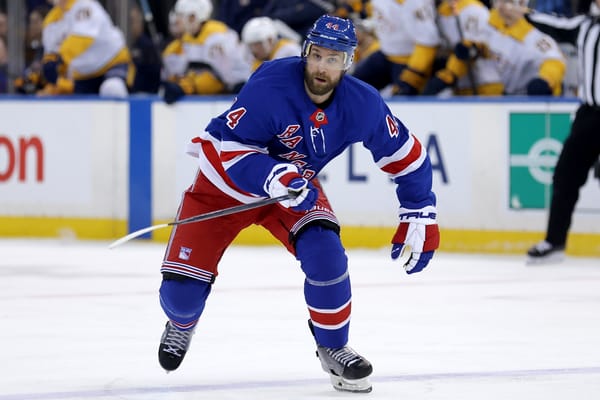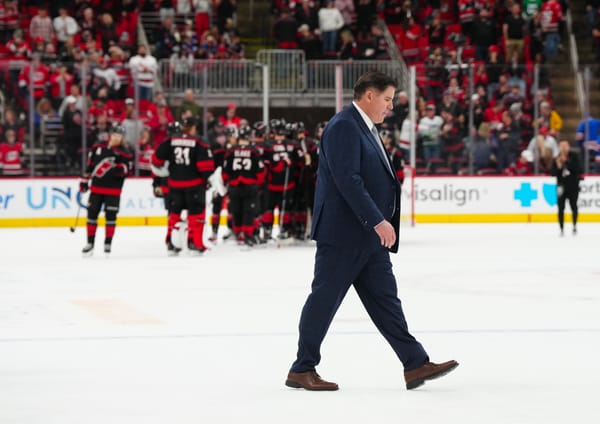From Start to Finish, the Rangers Handled Cam Talbot Perfectly
Cam Talbot's move away from the Rangers seems inevitable. It will be the bittersweet culmination of flawless development and bold execution by the Rangers since he joined the organization in 2010.
Barring any last-minute plot twists, this is likely the last I will write about Cam Talbot as a standing member of the New York Rangers. In an offseason that is expected to be filled with a lot of movement, somehow Talbot is one of the premier names on the trading block.
That's not to imply that it's unjustified; it's not. Talbot clearly proved last season that he is ready for a shot as an NHL starter. But it's a spectacular - and completely improbable - rise to relevance for the undrafted backup goaltender who played college hockey in Alabama and didn't even sniff the NHL until 26 years old. Obviously, a massive amount of credit should be given to Talbot for pushing himself to this level. What should not be taken for granted, however, is how the Rangers were spot-on in their handling of Talbot from the beginning until what appears to be the nearing end.
In the NHL, teams are limited to having 50 players under contract at a time. Because of that limit, teams have to be very careful with which prospects they sign. Scouts identify dozens of interesting free agents in the European leagues, Canadian juniors, and the NCAA. There's usually room to sign only one or two every spring. The Rangers prioritized Talbot, a goaltender playing at a college that had one NHL alumni in its entire history; Jared Ross, a center who played 13 total games for the Flyers. One might think the Rangers were out of their minds, thus, to target Talbot. However, they were far from alone. I spoke to Talbot's former head coach at Alabama-Huntsville, Danton Cole, just days prior to his first career NHL start, and he insisted that "between 10 and 15 teams" had expressed legitimate interest in Talbot. There was a big pool of teams from which Talbot chose. Great job by the Rangers' Director of Player Personnel, Gordie Clark, as well as Goaltending Coach Benoit Allaire, for convincing him to buy into their long-term vision for him and sign with the Rangers.
On October 14th, 2013, the Rangers placed Martin Biron on waivers and called up Talbot. Knowing what we know now, the decision seems pretty cut-and-dry. But at the time it was an incredibly bold move. Biron, during his time with the Rangers, was arguably the best backup goaltender in the NHL. Demoting him because of a few bad starts in the early part of the 2013-2014 season could have been viewed as a drastic move; particularly while replacing him with a completely unknown quantity that most outsiders had never even heard of before. Talbot had been playing very well in Hartford, but it was still a massive leap of faith that the Rangers were putting in Talbot and goaltending coach Benoit Allaire's judgment of him.
Right from the beginning, their audacious trust in Talbot paid off. Talbot won five of his first six starts and shut out the Canadiens in the Bell Centre, mystifying Habs fans and ending a long losing streak in Montreal. Talbot finished the season with a 12-6-1 record to go along with his .941 save percentage and 1.64 goals against average. The gamble worked, clearly, and now the Rangers had a younger, cheaper backup goaltender to be relied on.
Of course, things went to a whole different level this season. Marc Staal and Mats Zuccarello were both unrestricted free agents and were understandably at the forefront, but Cam Talbot too could have walked away at the end of the season. On December 19th, with a .928 save percentage through eight games on the season, the Rangers announced that they had signed Talbot to a one-year contract extension at a $1.45 million cap hit. One of the major reasons Talbot cited for committing to another season was getting to work with Benoit Allaire for a longer period of time.
This is right about the time where Talbot's tenure with the Rangers hit a new gear. Extending Talbot cheaply was a good move, no doubt, but the Rangers certainly did get lucky to an extent with the timing of it. Just 43 days later, Henrik Lundqvist was hit in the throat with a puck and soon after would be put on the shelf. The Rangers could have panicked and added a band-aid goaltender to the mix. Instead, they trusted Talbot, with just 28 career NHL starts, to play virtually every game for the next two months. Again, a significant leap of faith by the Rangers in Talbot paid off in dividends. He not only kept the ship afloat, but really put on a spectacular display. After a few shaky games, Talbot hit his groove and got hot just as the Rangers' goalscoring started to dip. From the time Talbot took over for Lundqvist until Lundqvist's return in late March, Talbot posted a blistering .935 save percentage to go with his 16-4-3 record. Talbot was in net against the Devils as the Rangers clinched the Presidents' Trophy, and he won the Steven McDonald Extra Effort Award for stepping into the starting role temporarily and not missing a beat. Had the Rangers not signed Talbot earlier, he most definitely takes advantage of his rising stock and makes bank in free agency. Instead, the Rangers are in the driver's seat and Talbot's migration will be on their terms.
It took five years of events to get to the current situation. A series of bold decisions, phenomenal mentoring by Benoit Allaire, and some fortunate timing sprinkled in have turned a previously no-name backup into one of the biggest players on the trade market entering Thursday's NHL Draft; he certainly is the top priority for teams looking for a goaltender. The Rangers acquired Talbot for free, got two incredibly productive years out of him at a bargain price, and now will most probably move him for a package of assets they badly need after emptying the cupboard for the likes of Rick Nash, Martin St. Louis, and Keith Yandle the last three seasons. It's a remarkable display of buying low and selling high.
Of course, the Rangers will have to replace Talbot and find a new backup goaltender. Cédric Desjardins, who started the season as the Rangers' third-string goaltender, is coming off a severe leg injury. There are no guarantees on his condition. Mackenzie Skapski is just 21 and the Rangers will prefer he play often and develop in Hartford. There's no obvious replacement for Talbot sitting at the Rangers' fingertips who is guaranteed to be successful in the role. But then again, who outside the Rangers' organization thought there was one for when Martin Biron departed? People might see Talbot's exodus as a blow to the team, but it should be viewed as a massive milestone. Another formerly reliable Rangers' backup goaltender, Steve Valiquette, likes to say that Benoit Allaire "could teach a monkey how to play goalie." With all due respect to Talbot, who worked hard to get to this point and has plenty of talent, he is replaceable when you have an eagle-eyed scouting staff and Allaire, the Mr. Miyagi of goaltending.
There is no room for emotions when making decisions in a salary cap world. Cam Talbot's departure will be bittersweet for both him and the Rangers. It's been an incredible experience watching his unlikely rise from obscurity into a legitimate goaltender respected and desired across the NHL. For Talbot, he'll be leaving the organization who gave him a chance the last five years and made him into the goaltender he is today. However, the Rangers will get a healthy profit on their investment instead of watching him walk away for nothing 12 months from now, and Talbot will get a much deserved promotion to at least a split starting role with a different organization. If the Rangers change course and retain Talbot for another season then this article will join the ranks of "Dewey Defeats Truman." However, it appears to be a foregone conclusion that Talbot will be traded within the next few days. And once the paperwork is signed for that swap it will be time for the Rangers to get to work on finding the next backup goaltender. The next bargain pickup. The next netminder who seamlessly fits the spot behind Lundqvist. The next one who can be depended upon to get the job done in the crease when needed; whether it's a spot start here and there or a 23-game stint with little rest right before the playoffs. The next under-the-radar puck stopper to make opposing fans say, "who the hell is this guy and how is he beating our team?"
The next Cam Talbot.




